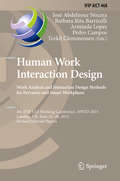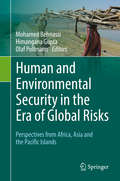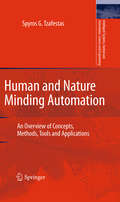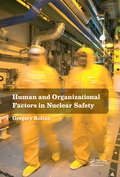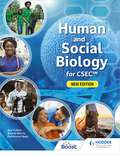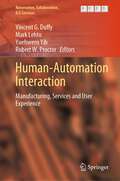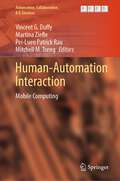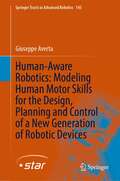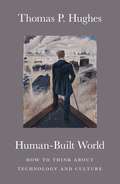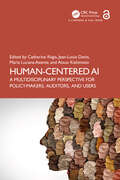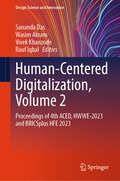- Table View
- List View
Human Walking in Virtual Environments: Perception, Technology, and Applications
by Anatole Lécuyer Frank Steinicke Jennifer Campos Yon VisellThis book presents a survey of past and recent developments on human walking in virtual environments with an emphasis on human self-motion perception, the multisensory nature of experiences of walking, conceptual design approaches, current technologies, and applications. The use of Virtual Reality and movement simulation systems is becoming increasingly popular and more accessible to a wide variety of research fields and applications. While, in the past, simulation technologies have focused on developing realistic, interactive visual environments, it is becoming increasingly obvious that our everyday interactions are highly multisensory. Therefore, investigators are beginning to understand the critical importance of developing and validating locomotor interfaces that can allow for realistic, natural behaviours. The book aims to present an overview of what is currently understood about human perception and performance when moving in virtual environments and to situate it relative to the broader scientific and engineering literature on human locomotion and locomotion interfaces. The contents include scientific background and recent empirical findings related to biomechanics, self-motion perception, and physical interactions. The book also discusses conceptual approaches to multimodal sensing, display systems, and interaction for walking in real and virtual environments. Finally, it will present current and emerging applications in areas such as gait and posture rehabilitation, gaming, sports, and architectural design.
Human Work Interaction Design. Work Analysis and Interaction Design Methods for Pervasive and Smart Workplaces
by José Abdelnour Nocera Barbara Rita Barricelli Arminda Lopes Pedro Campos Torkil ClemmensenThis book constitutes the thoroughly refereed post-conference proceedings of the 4th IFIP WG 13. 6 Working Conference on Human Work Interaction Design, HWID 2015, held in London, UK, in June 2015. The 15 revised full papers presented were carefully selected for inclusion in this volume. The papers reflect many different areas and address many complex and diverse work domains, focusing on the integration of work analysis and interaction design methods for pervasive and smart workplaces. They are organized in the following sections: methodologies; environment, and specific contexts.
Human Work Productivity: A Global Perspective
by Arunkumar Pennathur Anil Mital Shrawan KumarThe current global economic downturn and considerable shifting in industrial and manufacturing activities have disturbed the industrial order. However, human work productivity is still one of the most important components of the industrial economy and a determining factor in global competiveness and influence as well as the potential for technologi
Human and Ecological Risk Assessment: Theory and Practice - Set
by Dennis J. PaustenbachUnderstand the fundamentals of human risk assessment with this introduction and reference Human risk assessments are a precondition for virtually all industrial action or environmental regulation, all the more essential in a world where chemical and environmental hazards are becoming more abundant. These documents catalog potential environmental, toxicological, ecological, or other harms resulting from a particular hazard, from chemical spills to construction projects to dangerous workplaces. They turn on a number of variables, of which the most significant is the degree of human exposure to the hazardous agent or process. Human and Ecological Risk Assessment combines the virtues of a textbook and reference work to introduce and analyze these vital documents. Beginning with the foundational theory of human health risk assessment, it then supplies case studies and detailed analysis illustrating the practice of producing risk assessment documents. Fully updated and authored by leading authorities in the field, the result is an indispensable work. Readers of the second edition of Human and Ecological Risk Assessment will also find: Over 40 entirely new case studies reflecting the latest in risk assessment practice Detailed discussion of hazards including air emissions, contaminated food and soil, hazardous waste sites, and many more Case studies from multiple countries to reflect diverse international standards Human and Ecological Risk Assessment is ideal for professionals and advanced graduate students in toxicology, industrial hygiene, occupational medicine, environmental science, and all related subjects.
Human and Environmental Security in the Era of Global Risks: Perspectives from Africa, Asia and the Pacific Islands
by Mohamed Behnassi Olaf Pollmann Himangana GuptaThis book discusses ways to deepen the debate on the linkages between global risks and human and environmental security. The approach put forward in this book is one of questioning the ability of existing concepts, regulatory frameworks, technologies and decision-making mechanisms to accurately deal with emerging risks to human and environmental security, and to act in the direction of effectively managing their impacts and fostering the resilience of concerned systems and resources. Empirical research findings from Africa, Asia and the Pacific Islands are provided.During the last decades the links between emerging risks and the security of humans and nature have been the object of considerable research and deliberations. However, it is only recently becoming an important focus of policy making and advocacy. In this contributed volume, it is presumed that the ability – or lack thereof – to make innovative conceptual frameworks, institutional and policy arrangements, and technological advances for managing the current emerging risks, will foster or undermine the environmental security, and consequently determine the future human security. Moreover, taking into account the links between environmental/climate security, human security and sustainability will help frame a new research agenda and potentially develop a broad range of responses to many delicate questions.
Human and Machines: Philosophical Thinking of Artificial Intelligence (Human Intelligence)
by Yike Guo Jun GuThis book shares Chinese scholars’ philosophical views on artificial intelligence. The discussions range from the foundations of AI—the Turing test and creation of machine intelligence—to recent applications of AI, including decisions in games, natural languages, pattern recognition, prediction in economic contexts, autonomous behaviors, and collaborative intelligence, with the examples of AlphaGo, Microsoft’s Xiao Bing, medical robots, etc. The book’s closing chapter focuses on Chinese machines and explores questions on the cultural background of artificial intelligence. Given its scope, the book offers a valuable resource for all members of the general public who are interested in the future development of artificial intelligence, especially from the perspective of respected Chinese scholars.
Human and Nature Minding Automation
by Spyros G. TzafestasThis book examines the "symbiosis" of automation and technology with the human and the nature towards the ultimate goal of assuring global sustainability. Throughout the years a variety of approaches, technologies and practices have been produced in the direction of achieving human-and nature-minding automation and industrial activity. In this book an attempt is made, for the first time, to present in a cohesive and consolidated way an overview of all these issues together, and show how they combine to provide human-and nature-minding (green) systems. Human-minding automation is possible by employing concepts and techniques from the human factors and ergonomics fields, including job satisfaction, human-friendly interfaces, and human values, whereas nature-minding industrial activity and human development can be achieved by considering as a whole the human, economic, natural and cultural resources in the short and long term. In particular, nature-minding design selects the production methods and technologies that have the minimum impact to the nature. The book is intended for use both as a free reference conceptual book, and as general introductory book in relevant teaching and research environments.
Human and Organisational Factors: Practices and Strategies for a Changing World (SpringerBriefs in Applied Sciences and Technology)
by Corinne Bieder Claude Gilbert Benoît Journé Hervé LarocheThis open access book addresses several questions regarding the implementation of human and organisational factors (HOF) so that recent improvements in industrial safety can be built upon. It addresses sources of frustration in senior management with high expectations of operational recommendations and disquiet on the part of HOF specialists struggling to have an impact on high-level decision making. The brief explores these issues with an emphasis on examples and lessons learned based on the experience of its authors, who come from different academic disciplines and various industrial sectors such as oil and gas, energy and transportation. It then offers some ways forward for a better consideration of HOF in hazardous companies with a view of promoting safety and facing challenges in a rapidly changing world.
Human and Organizational Factors in Nuclear Safety: The French Approach to Safety Assessments
by Gregory RolinaThis book discusses the specifics of safety regulations regarding nuclear risk and the safety of nuclear installations. The author shows that (French) regulations concerning nuclear safety depend on maintaining a technical dialogue between the ASN, IRSN and nuclear operators. In the face of an ongoing European and global re-evaluation of the safety of nuclear power and alignment towards the Anglo-Saxon standard, the French approach may yet be able to make a significant contribution. This work will be of interest to all involved in nuclear power engineering and in the field of risk management and nuclear safety.
Human and Robot Hands
by Matteo Bianchi Alessandro MoscatelliThis booklooks at the common problems both human and robotic hands encounter when controllingthe large number of joints, actuators and sensors required to efficientlyperform motor tasks such as object exploration, manipulation and grasping. The authorsadopt an integrated approach to explore the control of the hand based onsensorimotor synergies that can be applied in both neuroscience androbotics. Hand synergies are based on goal-directed, combined muscle andkinematic activation leading to a reduction of the dimensionality of the motorand sensory space, presenting a highly effective solution for the fast and simplifieddesign of artificial systems. Presented intwo parts, the first part, Neuroscience, provides the theoretical andexperimental foundations to describe the synergistic organization of the humanhand. The second part, Robotics, Models and Sensing Tools, exploits theframework of hand synergies to better control and design robotic hands andhaptic/sensing systems/tools, using a reduced number of control inputs/sensors,with the goal of pushing their effectiveness close to the natural one. Human andRobot Hands provides a valuable reference for students, researchers anddesigners who are interested in the study and design of the artificial hand.
Human and Social Biology for CSEC
by Ann FullickProvide a comprehensive and engaging student-centred approach to Human and Social Biology with an updated textbook aligned to the latest CSEC syllabus for examination from June 2022. - Cover all topics with brand new content on the environment, diseases and pandemics with a full focus on their impact in the Caribbean - Develop subject knowledge with 'Did you know?' features; and consolidate learning using objectives, end of section checkpoint questions and summaries within each chapter- Create meaningful links with 'The Biologist's Toolkit' feature to strengthen maths, science and language skills needed to meet the course objectives- Support application of practical tasks via step-by-step guidance on how to research, present and analyse data, and come to realistic conclusions and recommendations - Avoid common errors with an increased focus on 'What the Examiners say' for problem topicsAdded for the eBook- Aid visual learning using diagrams, illustrations, video links and demonstrations in the eBook
Human and Social Biology for CSEC
by Ann FullickProvide a comprehensive and engaging student-centred approach to Human and Social Biology with an updated textbook aligned to the latest CSEC syllabus for examination from June 2022. - Cover all topics with brand new content on the environment, diseases and pandemics with a full focus on their impact in the Caribbean - Develop subject knowledge with 'Did you know?' features; and consolidate learning using objectives, end of section checkpoint questions and summaries within each chapter- Create meaningful links with 'The Biologist's Toolkit' feature to strengthen maths, science and language skills needed to meet the course objectives- Support application of practical tasks via step-by-step guidance on how to research, present and analyse data, and come to realistic conclusions and recommendations - Avoid common errors with an increased focus on 'What the Examiners say' for problem topicsAdded for the eBook- Aid visual learning using diagrams, illustrations, video links and demonstrations in the eBook
Human and Water Security in Israel and Jordan
by Philip Jan SchäferThe work aims at answering the question as to how far discourses on human security are present in Jordan and Israel, if they converge and if political solutions for the issue of water security could be derived. The analysis is based on the assumption that from human security perspective common solutions for urgent problems can be derived more easily than out of a perspective of national security. Yet it is acknowledged that according to a new security perspective different security threats are being identified by relevant actors. An empirical analysis of written statements and utterances of the respective security elites establishes the methodological tool for the identification of human security discourses in Israel and Jordan. Subsequently it is estimated how far water is presented as a matter of national security in Israel and Jordan using the theory of securitization.
Human-Automation Interaction Considerations for Unmanned Aerial System Integration into the National Airspace System: Proceedings Of A Workshop
by Engineering Medicine National Academies of SciencesPrior to 2012, unmanned aircraft systems (UAS) technology had been primarily used by the military and hobbyists, but it has more recently transitioned to broader application, including commercial and scientific applications, as well as to expanded military use. These new uses encroach on existing structures for managing the nation’s airspace and present significant challenges to ensure that UASs are coordinated safely and suitably with existing manned aircraft and air traffic management systems, particularly with the National Airspace System (NAS). Of particular concern is the interaction between human pilots, operators, or controllers and increasingly automated systems. Enhanced understanding of these interactions is essential to avoid unintended consequences, especially as new technologies emerge. In order to explore these issues, the National Academies of Sciences, Engineering, and Medicine organized a 2-day workshop in January 2018. This publication summarizes the presentations and discussions from the workshop.
Human-Automation Interaction Design: Developing a Vehicle Automation Assistant (Transportation Human Factors)
by Neville A. Stanton Jediah R. Clark Kirsten RevellThis text presents a four-step approach for applying communicative concepts to driving automation, including: scoping, piloting, designing, and testing. It further provides experimental data on how practical human-human communication strategies can be applied to interaction in automated vehicles. The book explores the role of communication and the nature of situation awareness in automated vehicles to ensure safe and usable automated vehicle operation. It covers the issue of interaction in automated vehicles by providing insight into communicative concepts, the transfer of control in human-teams, and how these concepts can be applied in automated vehicles. The theoretical framework is built on by presenting experimental findings, design workshop output and providing a demonstration of prototype generation for automated assistants that addresses a wide range of performance outcomes within human-machine interaction. Aimed at professionals, graduate students, and academic researchers in the fields of ergonomics, automotive engineering, transportation engineering, and human factors, this text: Discusses experimental findings on how practical human-human communication strategies can be applied to interaction in automated vehicles. Provides a four-step approach for applying communicative concepts to driving automation, including: scoping, piloting, designing and testing. Explores the role of distributed situation awareness in automated vehicles. Covers communication and system awareness in response to multiple complex road scenarios. Provides design guidelines for automation-human handover design.
Human-Automation Interaction: Manufacturing, Services and User Experience (Automation, Collaboration, & E-Services #10)
by Robert W. Proctor Vincent G. Duffy Yuehwern Yih Mark LehtoThis book provides practical guidance and awareness for a growing body of knowledge developing across a variety of disciplines and many countries. This book is a celebration of the Gavriel Salvendy International Symposium (GSIS) and provides a survey of topics and emerging areas of interest in human–automation interaction. This book for the GSIS emphasizes main thematic areas: manufacturing, services and user experience. Main areas of coverage include Section A: Advanced Production Management and Production Control; Section B: Healthcare Automation; Section C: Measuring and Modeling Human Performance; Section D: Usability and User Experience; Section E: Safety Management and Occupational Ergonomics; Section F: Manufacturing and Services; Section G: Data and Probabilistic Information; Section H: Training and Collaboration Technologies. Contributions from especially early career researchers were featured as part of this (virtual) symposium and celebration. Gavriel Salvendy initiated the conferences that run annually as Human–Computer Interaction International and Applied Human Factors and Ergonomics International (AHFE), both within the Lecture Notes in Springer. The book is inclusive of human–computer interaction and human factors and ergonomics principles, yet it is intended to serve a much wider audience that has interest in automation and human modeling. The emerging need for human–automation interaction expertise has developed from an ever-growing availability and presence of automation in our everyday lives.
Human-Automation Interaction: Mobile Computing (Automation, Collaboration, & E-Services #12)
by Martina Ziefle Vincent G. Duffy Pei-Luen Patrick Rau Mitchell M. TsengThis book provides practical guidance and awareness for a growing body of knowledge developing across a variety of disciplines. This initiative is a celebration of the Gavriel Salvendy International Symposium (GSIS) and provides a survey of topics and emerging areas of interest in human–automation interaction. This set of articles for the GSIS emphasizes a main thematic areas: mobile computing. Main areas of coverage include Section A: Health, Care and Assistive Technologies; Section B: Usability, User Experience and Design; Section C: Virtual Learning, Training and Collaboration; Section D: Ergonomics in Work, Automation and Production. In total, there are more than 600 pages emphasizing contributions from especially early career researchers that were featured as part of this (virtual) symposium and celebration. Gavriel Salvendy initiated the conferences that run annually as Human–Computer Interaction within LNCS of Springer and Applied Human Factors and Ergonomics International (AHFE). The book is inclusive of human–computer interaction and human factors and ergonomics principles, yet is intended to serve a much wider audience that has interest in automation and human modeling. The emerging need for human–automation interaction expertise has developed from an ever-growing availability and presence of automation in our everyday lives. This initiative is intended to provide practical guidance and awareness for a growing body of knowledge developing across a variety of disciplines and many countries.
Human-Automation Interaction: Transportation (Automation, Collaboration, & E-Services #11)
by John D. Lee Vincent G. Duffy Neville Stanton Steven J. LandryThis book provides practical guidance and awareness for a growing body of knowledge developing across a variety of disciplines. This initiative is a celebration of the Gavriel Salvendy International Symposium (GSIS) and provides a survey of topics and emerging areas of interest in human–automation interaction. This set of articles for the GSIS emphasizes a main thematic area: transportation. Main areas of coverage include Section A: Interaction with Vehicle Automation; Section B: HCI in Automated Vehicles; Section C: Trust in Vehicle Automation; Section D: Physical Modeling of Vehicle Cabs; Section E: Task Simulation Automation via Digital Human Models; Section F: Maintenance and Manufacturing; Section G: Smart Cities and Connected Vehicles. Contributions from especially early career researchers were featured as part of this (virtual) symposium and celebration. Gavriel Salvendy initiated the conferences that run annually as Human–Computer Interaction within LNCS of Springer and Applied Human Factors and Ergonomics International (AHFE). The book is inclusive of human–computer interaction and human factors and ergonomics principles, yet it is intended to serve a much wider audience that has interest in automation and human modeling. The emerging need for human–automation interaction expertise has developed from an ever-growing availability and presence of automation in our everyday lives. This initiative is intended to provide practical guidance and awareness for a growing body of knowledge developing across a variety of disciplines and many countries.
Human-Aware Robotics: Modeling Human Motor Skills for the Design, Planning and Control of a New Generation of Robotic Devices (Springer Tracts in Advanced Robotics #145)
by Giuseppe AvertaThis book moves from a thorough investigation of human capabilities during movements and interactions with objects and environment and translates those principles into the design planning and control of innovative mechatronic systems, providing significant advancements in the fields of human–robot interaction, autonomous robots, prosthetics and assistive devices. The work presented in this monograph is characterized by a significant paradigmatic shift with respect to typical approaches, as it always place the human at the center of the technology developed, and the human represents the starting point and the actual beneficiary of the developed solutions. The content of this book is targeted to robotics and neuroscience enthusiasts, researchers and makers, students and simple lovers of the matter.
Human-Built World: How to Think about Technology and Culture
by Thomas P. HughesTo most people, technology has been reduced to computers, consumer goods, and military weapons; we speak of "technological progress" in terms of RAM and CD-ROMs and the flatness of our television screens. In Human-Built World, thankfully, Thomas Hughes restores to technology the conceptual richness and depth it deserves by chronicling the ideas about technology expressed by influential Western thinkers who not only understood its multifaceted character but who also explored its creative potential. Hughes draws on an enormous range of literature, art, and architecture to explore what technology has brought to society and culture, and to explain how we might begin to develop an "ecotechnology" that works with, not against, ecological systems. From the "Creator" model of development of the sixteenth century to the "big science" of the 1940s and 1950s to the architecture of Frank Gehry, Hughes nimbly charts the myriad ways that technology has been woven into the social and cultural fabric of different eras and the promises and problems it has offered. Thomas Jefferson, for instance, optimistically hoped that technology could be combined with nature to create an Edenic environment; Lewis Mumford, two centuries later, warned of the increasing mechanization of American life. Such divergent views, Hughes shows, have existed side by side, demonstrating the fundamental idea that "in its variety, technology is full of contradictions, laden with human folly, saved by occasional benign deeds, and rich with unintended consequences. " In Human-Built World, he offers the highly engaging history of these contradictions, follies, and consequences, a history that resurrects technology, rightfully, as more than gadgetry; it is in fact no less than an embodiment of human values.
Human-Centered AI: A Multidisciplinary Perspective for Policy-Makers, Auditors, and Users (Chapman & Hall/CRC Artificial Intelligence and Robotics Series)
by Jean-Louis Denis Catherine Régis Maria Luciana Axente Atsuo KishimotoArtificial intelligence (AI) permeates our lives in a growing number of ways. Relying solely on traditional, technology-driven approaches won't suffice to develop and deploy that technology in a way that truly enhances human experience. A new concept is desperately needed to reach that goal. That concept is Human-Centered AI (HCAI).With 29 captivating chapters, this book delves deep into the realm of HCAI. In Section I, it demystifies HCAI, exploring cutting-edge trends and approaches in its study, including the moral landscape of Large Language Models. Section II looks at how HCAI is viewed in different institutions—like the justice system, health system, and higher education—and how it could affect them. It examines how crafting HCAI could lead to better work. Section III offers practical insights and successful strategies to transform HCAI from theory to reality, for example, studying how using regulatory sandboxes could ensure the development of age-appropriate AI for kids. Finally, decision-makers and practitioners provide invaluable perspectives throughout the book, showcasing the real-world significance of its articles beyond academia.Authored by experts from a variety of backgrounds, sectors, disciplines, and countries, this engaging book offers a fascinating exploration of Human-Centered AI. Whether you're new to the subject or not, a decision-maker, a practitioner or simply an AI user, this book will help you gain a better understanding of HCAI's impact on our societies, and of why and how AI should really be developed and deployed in a human-centered future.
Human-Centered Agriculture: Ergonomics and Human Factors Applied (Design Science and Innovation)
by P. K. Nag L. P. GiteThis book explores the interplay of farm mechanization, human factors and climatic and other environmental uncertainty in agriculture, using an ergonomics based approach to discuss solutions to the traditionally acknowledged vulnerability of the sector. It converges contemporary research documentation, case studies and international standards on agricultural ergonomics, engineering anthropometry, human factors, basic occupational health services, safety management, human performance and system sustainability to provide a handy reference to students and professionals working to optimize agricultural output while balancing the rational utilization of labour in agricultural practices and human well-being.
Human-Centered Computing: Cognitive, Social, and Ergonomic Aspects, Volume 3
by Michael Smith Constantine Stephanidis Don Harris Vincent DuffyThe 10th International Conference on Human-Computer Interaction, HCI International 2003, is held in Crete, Greece, 22-27 June 2003, jointly with the Symposium on Human Interface (Japan) 2003, the 5th International Conference on Engineering Psychology and Cognitive Ergonomics, and the 2nd International Conference on Universal Access in Human-Computer Interaction. A total of 2986 individuals from industry, academia, research institutes, and governmental agencies from 59 countries submitted their work for presentation, and only those submittals that were judged to be of high scientific quality were included in the program. These papers address the latest research and development efforts and highlight the human aspects of design and use of computing systems. The papers accepted for presentation thoroughly cover the entire field of humancomputer interaction, including the cognitive, social, ergonomic, and health aspects of work with computers. These papers also address major advances in knowledge and effective use of computers in a variety of diversified application areas, including offices, financial institutions, manufacturing, electronic publishing, construction, health care, disabled and elderly people, etc.
Human-Centered Design for Mining Equipment and New Technology
by Tim Horberry Robin Burgess-Limerick Lisa J. SteinerHuman-Centered Design for Mining Equipment and New Technology first introduces Human-Centered Design (HCD) and outlines the benefits of this approach for mining equipment and new technology: HCD is a process that aims to make equipment and systems more usable and acceptable by explicitly focusing on the end-user, their tasks and their work environment/use context. The book outlines three linked areas of mining HCD: key principles, examples of design processes, and what kinds of tools for data collection and evaluation are available. <P><P>The possible future uses of Human-Centered Design in more fully automated mining are presented, and the role of HCD within wider human system integration are outlined. The ‘how to’ nature of this book makes it attractive to mining equipment manufacturers, technology developers, mine site personnel, human factors researchers, safety scientists and regulators. <P><P>Features: <P><P>Includes an introduction useful to anyone wanting to learn about the field <P><P>Provides extensive case studies of HCD which also show failures when HCD was not considered <P><P>Covers cutting edge mining technology- such as proximity detection devices and new mining automation systems <P><P>Directly outlines the benefits of HCD for the minerals industry <P><P>Human-Centered Design for Mining Equipment and New Technology, through case studies, provides a much needed guide to undertaking HCD for mining equipment and new technology.
Human-Centered Digitalization, Volume 2: Proceedings of 4th ACED, HWWE-2023 and BRICSplus HFE 2023 (Design Science and Innovation)
by Rauf Iqbal Vivek Khanzode Wasim Akram Sananda DasThis book presents select proceedings of the Joint International Conference on Humanizing Work and Work Environment (HWWE-2023), ACED2023, and BRICSplus HFE2023 conducted at IIM Mumbai. The conference proceedings examine a range of issues confronted by researchers and practitioners in the field of ergonomics and human factors engineering today. The topics dealt with in this volume include physical ergonomics, workplace design, product design for usability, user interface and experience design, assessment of cognitive workload, digital ergonomics, and other relevant topics in this domain. The book also discusses various methodological approaches used by researchers and scientists in the field of ergonomics, such as participatory ergonomics, survey research, experimental design, data-driven modeling, AI and ML methodologies in Ergonomics and HFE, and other recent approaches. This book will be a useful reference for students, faculty, researchers, practitioners, professionals, and consultants in the field of ergonomics, human factors engineering, and worksystem design.

